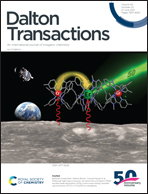N,N-Ru(ii)-p-cymene-poly(N-vinylpyrrolidone) surface functionalized gold nanoparticles: from organoruthenium complex to nanomaterial for antiproliferative activity†
Abstract
Organometallic Ru–arene complexes are promising as anticancer agents, but the lack of tumor uptake and poor solubility in the physiological medium impede their development. In order to deal with these challenges, we developed gold nanoparticles coated with Ru(arene)-functionalized PNVP-Py, where PNVP-Py is pyridine end-functionalized poly(N-vinylpyrrolidone). It is demonstrated that these particles exhibit higher anti-proliferative activity than the individual organometallic ruthenium(II) complex of the type [Ru(η6-p-cymene)(NN)Cl]PF6, where NN is bis(4-methoxyphenylimino)acenaphthene, against colorectal adenocarcinoma cell lines. More specifically, a RuII(η6-p-cymene) complex containing a NN bidentate ligand has been prepared and characterized by spectral studies and X-ray crystallography. To tether the isolated complex onto the surface of the AuNPs, PNVP-Py, which contains a pyridine group at one end to coordinate to the Ru-complex and a suitable functional group at the other end to bind on the surface of the AuNPs, has been prepared and utilized to obtain the macromolecular complex [Ru(η6-p-cymene)(NN)(PNVP-Py)]Cl2. Next, stable Ru(p-cym)(NN)(PNVP-Py)@AuNPs were obtained via a ligand exchange reaction of citrate-stabilized AuNPs with a macromolecular complex by a direct ‘grafting to’ approach and characterized well. Despite the lower DNA cleavage activity, the nanoconjugate exhibits better cytotoxicity than the individual complex against HT-29 colorectal adenocarcinoma cells on account of its enhanced permeability across the cell membrane. The AO/EB staining assay revealed that the nanoconjugate is able to induce an apoptotic mode of cell death, which was further quantitatively evaluated by Annexin V-FITC/PI double assay. An immunofluorescence assay indicated the higher potency of the nanoconjugate to inhibit cyclin D1 gene expression that is required for cancer cell growth. To the best of our knowledge, this is the first report of the modification of an organometallic Ru(arene) complex into a Ru(arene)metallopolymer–gold nanoconjugate for the development of ruthenium-based nanomedicine for cancer treatment.



 Please wait while we load your content...
Please wait while we load your content...